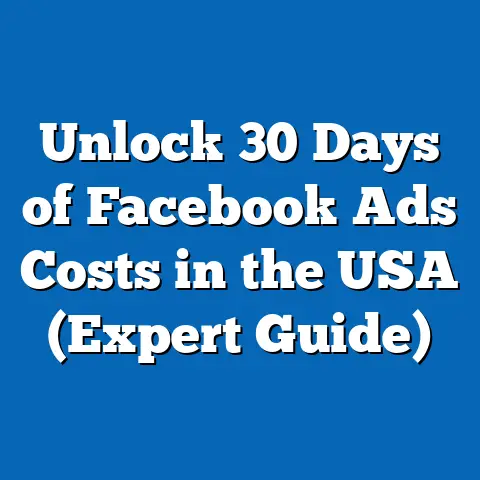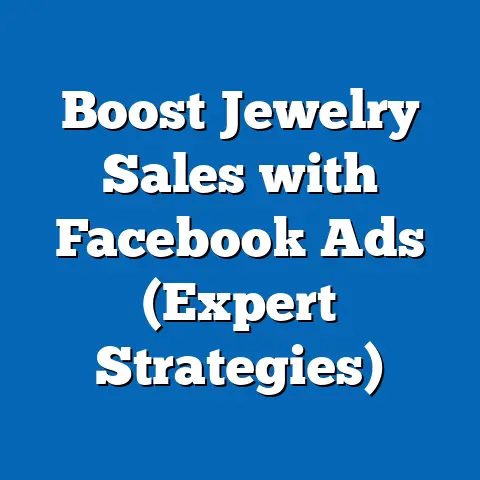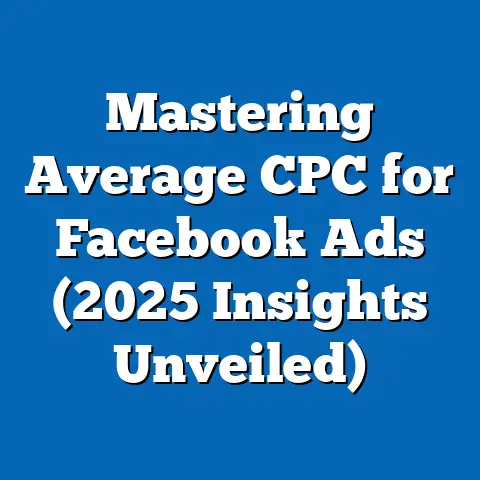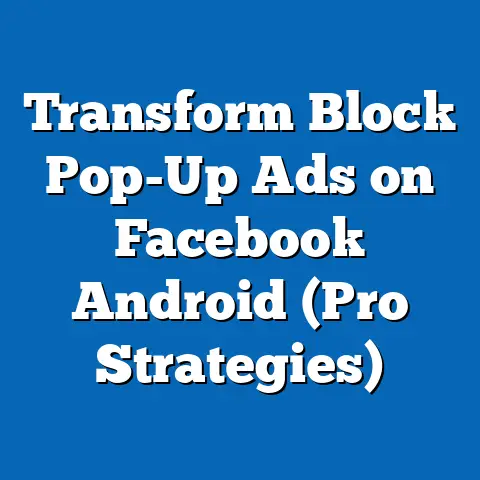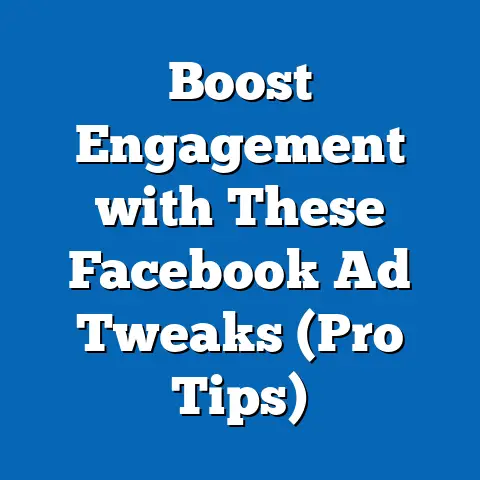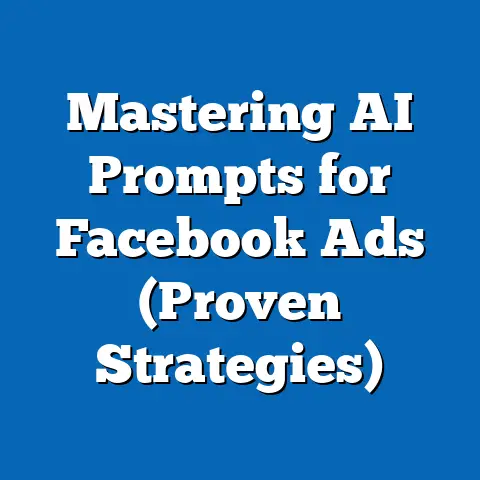Unlock Facebook Ads Revenue Insights (Expert Strategies)
Remember that time my buddy tried selling “invisible” dog leashes on Facebook? Yeah, you read that right. Invisible. Dog. Leashes. He was convinced it was the next big thing, a revolutionary way to walk your dog without, you know, actually holding a leash. He ended up with zero sales and a whole lot of confused comments. That hilarious (and slightly painful) experience really hammered home one crucial point: just throwing money at Facebook ads without a solid strategy is like shouting into the void. You might get some attention, but you’re not going to generate any revenue.
In today’s digital marketing landscape, Facebook ads are a powerhouse. Businesses big and small are leveraging Facebook’s massive audience to drive sales, boost brand awareness, and connect with customers. But with so much noise and competition, how do you actually unlock the revenue insights hidden within your Facebook ad campaigns? That’s what I’m here to help you with. This guide will walk you through expert strategies to transform your Facebook ads from a cost center into a revenue-generating machine. Let’s dive in!
Understanding Facebook Ads Basics
Before we get into the nitty-gritty, let’s cover the fundamentals. Facebook ads are essentially paid messages that businesses use to reach a specific audience on the Facebook platform. Unlike organic posts, which rely on algorithms and luck to reach your target demographic, ads guarantee visibility to the people you want to reach.
There’s a whole buffet of ad formats to choose from, each with its own unique strengths:
-
Image Ads: These are your classic, single-image ads. They’re simple, effective, and great for showcasing a product or service visually.
-
Video Ads: Video is king! These ads are highly engaging and perfect for telling a story or demonstrating how your product works.
-
Carousel Ads: Showcase multiple products or features in a single ad unit. Users can swipe through the carousel to see different images or videos. I’ve seen carousel ads work wonders for e-commerce businesses.
-
Collection Ads: Designed for mobile shopping, these ads combine a video or image with a selection of products that users can browse and purchase directly.
-
Lead Ads: Capture leads directly within the Facebook platform. These are fantastic for building your email list or gathering information from potential customers.
-
Instant Experience Ads: These are full-screen, mobile-optimized experiences that open when someone clicks on your ad. They offer a highly immersive and engaging way to showcase your brand.
Image Ads: These are your classic, single-image ads. They’re simple, effective, and great for showcasing a product or service visually.
Video Ads: Video is king! These ads are highly engaging and perfect for telling a story or demonstrating how your product works.
Carousel Ads: Showcase multiple products or features in a single ad unit. Users can swipe through the carousel to see different images or videos. I’ve seen carousel ads work wonders for e-commerce businesses.
Collection Ads: Designed for mobile shopping, these ads combine a video or image with a selection of products that users can browse and purchase directly.
Lead Ads: Capture leads directly within the Facebook platform. These are fantastic for building your email list or gathering information from potential customers.
Instant Experience Ads: These are full-screen, mobile-optimized experiences that open when someone clicks on your ad. They offer a highly immersive and engaging way to showcase your brand.
Why should you even bother with Facebook ads? Well, consider this: Facebook boasts over 3 billion monthly active users. That’s a massive pool of potential customers! And with Facebook’s sophisticated targeting options, you can pinpoint your ideal audience with laser-like precision.
Key Takeaway: Facebook ads are a powerful tool for reaching a vast and targeted audience. Understanding the different ad formats is the first step toward creating successful campaigns.
Setting Clear Goals for Your Ads
Okay, so you know what Facebook ads are. Great! But before you start throwing money around, you need to define what you want to achieve. This is where setting clear, measurable goals comes in. Think of it like this: you wouldn’t start a road trip without knowing your destination, right? Same goes for Facebook ads.
Are you trying to:
- Increase brand awareness? This means getting your brand in front of as many people as possible. The goal here is visibility.
- Drive traffic to your website? Focus on click-through rate and landing page views.
- Generate leads? Aim for lead form submissions or email sign-ups.
- Drive sales? Track conversions and revenue generated from your ads.
A vague goal like “get more customers” isn’t going to cut it. You need to be specific. That’s where the SMART framework comes in:
- Specific: What exactly do you want to achieve?
- Measurable: How will you track your progress?
- Achievable: Is your goal realistic?
- Relevant: Does your goal align with your overall business objectives?
- Time-bound: When do you want to achieve your goal?
For example, instead of “get more customers,” a SMART goal might be: “Increase online sales by 15% in the next quarter through Facebook ads.”
Why is this so important? Because clear goals dictate your entire strategy. They influence your targeting, your ad copy, your visuals, and your budget allocation. Without them, you’re just shooting in the dark.
Key Takeaway: Define specific, measurable, achievable, relevant, and time-bound (SMART) goals for your Facebook ad campaigns. This will provide a clear roadmap for success.
Targeting the Right Audience
Now for the fun part: finding your ideal customers! Facebook’s targeting options are incredibly powerful, allowing you to reach people based on a wide range of factors.
Here’s a breakdown of some key targeting options:
- Demographics: Target people based on age, gender, location, education, job title, and more.
- Interests: Reach people who have expressed interest in specific topics, hobbies, or brands.
- Behaviors: Target people based on their online activities, purchase history, device usage, and more.
- Custom Audiences: Upload your own customer data (email lists, phone numbers, etc.) to create targeted audiences. This is great for reaching existing customers or creating lookalike audiences.
- Lookalike Audiences: Find new customers who are similar to your existing customers. Facebook analyzes your custom audiences to identify common traits and then finds other users who share those traits. This is one of my go-to strategies for scaling campaigns.
My experience has taught me that A/B testing different audience segments is crucial. You might think you know your ideal customer, but data often reveals surprising insights. For instance, I once assumed my target audience for a fitness product was primarily young adults. Turns out, the highest-converting audience was actually middle-aged individuals!
Another powerful tool is the Facebook Pixel. This is a small piece of code that you install on your website. It allows Facebook to track the actions that people take on your website after clicking on your ad, such as adding items to their cart, making a purchase, or filling out a form. This data is invaluable for retargeting website visitors who didn’t convert and optimizing your campaigns for conversions.
Key Takeaway: Leverage Facebook’s powerful targeting options to reach your ideal customers. Experiment with different audience segments and use the Facebook Pixel to track conversions and retarget website visitors.
Crafting Compelling Ad Copy and Visuals
You’ve got your goals, you’ve got your audience. Now it’s time to create ads that actually grab attention and drive results. This is where compelling ad copy and visuals come into play.
Think of your ad as a tiny billboard competing for attention in a crowded digital landscape. It needs to be eye-catching, relevant, and persuasive.
Here are some key elements of high-performing ad copy:
- A clear and concise headline: This is the first thing people will see, so make it count! Use strong verbs, highlight benefits, and create a sense of urgency.
- A compelling description: Expand on your headline and provide more details about your product or service. Focus on solving a problem or fulfilling a need.
- A strong call-to-action (CTA): Tell people what you want them to do! Use clear and direct CTAs like “Shop Now,” “Learn More,” or “Sign Up.”
Visuals are equally important. Choose images or videos that are high-quality, relevant, and visually appealing. Consider these tips:
- Use professional-looking images: Avoid blurry or pixelated images.
- Show your product in action: Demonstrate how your product works or how it can benefit the user.
- Use bright colors and eye-catching graphics: Make your ad stand out from the crowd.
- Consider using video: Video ads are highly engaging and can be a great way to tell a story or showcase your brand.
One of the most effective strategies I’ve used is visual storytelling. Instead of simply showcasing a product, I try to create a narrative that resonates with the target audience. For example, for an ad promoting travel insurance, I might use a video showing a family enjoying a worry-free vacation, knowing they’re protected in case of any unexpected events.
Let’s dissect an example of a successful ad: a local bakery ran an ad featuring a mouthwatering picture of their freshly baked croissants, with the headline “Start Your Day with the Best Croissants in Town!” The description highlighted the bakery’s commitment to using high-quality ingredients and the call-to-action was “Order Online Now.” This ad was incredibly effective because it combined a visually appealing image with a clear and compelling message.
Key Takeaway: Craft compelling ad copy and visuals that grab attention and resonate with your target audience. Use clear headlines, persuasive descriptions, strong CTAs, and high-quality images or videos.
How much should you spend on Facebook ads? And how should you bid for ad placements? These are crucial questions that can significantly impact your ROI.Determining your ad budget depends on several factors, including your business goals, audience size, and competition. A good starting point is to allocate a percentage of your overall marketing budget to Facebook ads. A common benchmark is 5-10%, but this can vary depending on your industry and objectives.
Facebook offers several bidding strategies to choose from:
-
Cost Per Click (CPC): You pay each time someone clicks on your ad. This is a good option if your goal is to drive traffic to your website.
-
Cost Per Thousand Impressions (CPM): You pay for every 1,000 impressions (times your ad is shown). This is a good option if your goal is to increase brand awareness.
-
Cost Per Acquisition (CPA): You pay only when someone takes a specific action, such as making a purchase or filling out a form. This is the most performance-driven option, but it requires accurate tracking of conversions.
Cost Per Click (CPC): You pay each time someone clicks on your ad. This is a good option if your goal is to drive traffic to your website.
Cost Per Thousand Impressions (CPM): You pay for every 1,000 impressions (times your ad is shown). This is a good option if your goal is to increase brand awareness.
Cost Per Acquisition (CPA): You pay only when someone takes a specific action, such as making a purchase or filling out a form. This is the most performance-driven option, but it requires accurate tracking of conversions.
Which bidding strategy should you choose? It depends on your goals and your level of experience. If you’re just starting out, I recommend using CPC or CPM. As you gain more experience and start tracking conversions, you can switch to CPA bidding.
It’s also important to monitor your ad performance and adjust your budget accordingly. If your ads are performing well, you can increase your budget to reach a larger audience. If your ads are underperforming, you can decrease your budget or pause your campaign altogether.
Key Takeaway: Determine your ad budget based on your business goals and audience size. Experiment with different bidding strategies and monitor your ad performance to optimize your spending.
Analyzing and Interpreting Data Insights
You’ve launched your campaigns, and the data is flowing in. Now what? This is where the real magic happens. Analyzing and interpreting data insights is crucial for optimizing your campaigns and maximizing your ROI.
The Facebook Ads Manager provides a wealth of data on your ad performance. Some key metrics to track include:
- Impressions: The number of times your ad was shown.
- Reach: The number of unique people who saw your ad.
- Click-Through Rate (CTR): The percentage of people who clicked on your ad after seeing it.
- Conversion Rate: The percentage of people who completed a desired action (e.g., making a purchase) after clicking on your ad.
- Cost Per Acquisition (CPA): The cost of acquiring one customer through your ad campaign.
- Return on Ad Spend (ROAS): The revenue generated for every dollar spent on advertising.
Understanding these metrics is essential for identifying what’s working and what’s not. For example, if your CTR is low, it might indicate that your ad copy or visuals are not compelling enough. If your conversion rate is low, it might indicate that your landing page is not optimized for conversions.
I’ve found that running experiments is one of the most effective ways to optimize campaigns. Try A/B testing different headlines, images, or CTAs to see which ones perform best. You can also experiment with different audience segments or bidding strategies.
Ultimately, the goal is to use data to inform your future ad strategies. By continuously analyzing your results and making adjustments based on data insights, you can significantly improve your campaign performance and unlock more revenue.
Key Takeaway: Track key metrics in the Facebook Ads Manager and use data insights to optimize your campaigns. Run experiments to test different elements of your ads and use the results to inform your future strategies.
Conclusion
Unlocking revenue insights from Facebook ads isn’t about luck; it’s about strategy. From understanding the basics to setting clear goals, targeting the right audience, crafting compelling ads, managing your budget, and analyzing your data, each step is crucial for success.
Remember my friend with the invisible dog leashes? Well, with the strategies I’ve outlined here, you can avoid his fate and turn your Facebook ads into a powerful revenue-generating tool. So, go forth, experiment, analyze, and unlock your own Facebook ads revenue insights! The digital world is waiting to be conquered, one well-targeted ad at a time.

